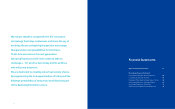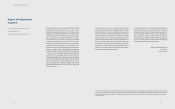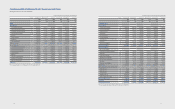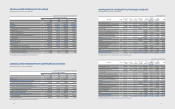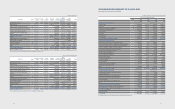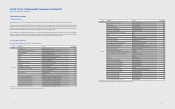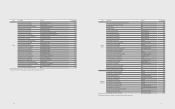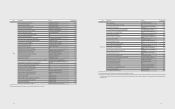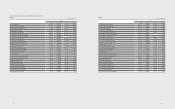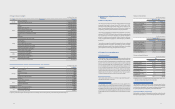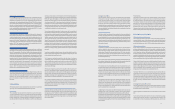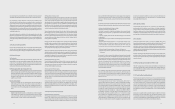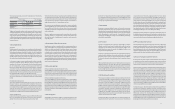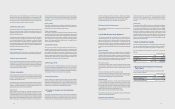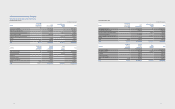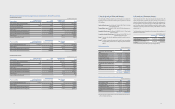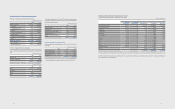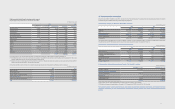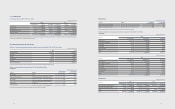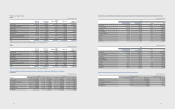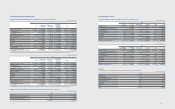Samsung 2012 Annual Report Download - page 33
Download and view the complete annual report
Please find page 33 of the 2012 Samsung annual report below. You can navigate through the pages in the report by either clicking on the pages listed below, or by using the keyword search tool below to find specific information within the annual report.
K-IFRS 1113, ‘Fair value measurement’
The standard aims to improve consistency and reduce complexity by providing
a precise definition of fair value and a single source of fair value measurement
and disclosure requirements for use across Financial Reporting Standards. The
requirements, which are largely aligned between IFRS and US GAAP, do not extend
the use of fair value accounting but provide guidance on how it should be applied
where its use is already required or permitted by other standards within IFRS or US
GAAP. The Company is still in the process of assessing the impact of the amendment
on the consolidated nancial statements and intends to adopt K-IFRS 1113 no later
than the accounting period beginning January 1, 2013.
K-IFRS 1110, ‘Consolidated nancial statements’
The standard explains the principle of control which is the basis for determining
which entities are consolidated in the consolidated nancial statements. An investor
controls an investee when it is exposed, or has rights, to variable returns from its
involvement with the investee and has the ability to aect those returns through its
power over the investee. The standard sets out further guidance where it is dicult
to determine control. The standard will be effective for the fiscal year beginning
January 1, 2013. The Company is in the process of assessing the impact of the
standard on the consolidated nancial statements.
K-IFRS 1111, ‘Joint arrangements Introduction’
The standard reects the essence of joint arrangements and focuses on the rights
and obligations of the parties to the joint arrangements rather than on the legal
forms of the arrangements. The standard classifies joint arrangements into joint
operations and joint ventures. A joint operation is a joint arrangement whereby the
parties that have joint control of the arrangement (i.e. joint operators) have rights
to the assets, and obligations for the liabilities, relating to the arrangement. A joint
operator accounts for the assets, liabilities, revenues and expenses in relation to
its interest in the arrangement. A joint venture is a joint arrangement whereby the
parties that have joint control of the arrangement (i.e. joint venturers) have rights
to the net assets of the arrangement. Joint venturers account for the investment
using the equity method. The standard will be eective for the scal year beginning
January 1, 2013. The Company is in the process of assessing the impact of the
standard on the consolidated nancial statements.
K-IFRS 1111, ‘Joint arrangements Introduction’
The standard provides disclosure requirements for all types of equity investments
in other entities including subsidiaries, joint arrangements, associates, consolidated
structured entities and unconsolidated structured entities. The standard will be
effective for the fiscal year beginning January 1, 2013. The Company is in the
process of assessing the impact of the standard on the consolidated financial
statements.
2.3 Consolidation
The Company prepares annual consolidated financial statements in accordance
with K-IFRS 1027, Consolidated and Separate Financial Statements.
(A) Subsidiaries
The consolidated financial statements include the accounts of SEC and its
controlled subsidiaries. Control over a subsidiary is presumed to exist when the
Company has the power to govern the nancial and operating policies of an entity
to obtain benefits from its activities generally accompanying a shareholding of
more than one half of the voting rights. The existence and eects of potential voting
rights that are exercisable or convertible at the end of the reporting period are
considered in determining whether the Company controls another entity. Moreover,
K-IFRS 1027 requires the evaluation of whether the Company holds control over the
nancial and operating policies of a subsidiary where the Company’s shareholding
is less than or equal to 50%. Control is presumed to exist when the Company is
considered to have control over the nancial and operating policies of a subsidiary
through its ownership relative to those of other shareholders. Subsidiaries are fully
consolidated from the date when control is transferred to the Company and de-
consolidated from the date which control ceases to exist.
The purchase method of accounting is used to account for the acquisition of
subsidiaries by the Company. The cost of an acquisition is measured at the fair value
of the assets given, equity instruments issued and liabilities incurred or assumed
at the date of exchange. Identiable assets acquired and liabilities and contingent
liabilities assumed in a business combination are measured initially at their fair
values at the acquisition date, irrespective of the extent of any non-controlling
interest. The excess of the cost of acquisition over the fair value of the Company’s
share of the identifiable net assets acquired is recorded as goodwill. If the cost of
acquisition is less than the fair value of the net assets of the subsidiary acquired,
the dierence is recognized directly in the statement of income. For each business
combination, the Company measures any non-controlling interest in the acquiree
at the non-controlling interest’s proportionate share of the acquiree’s identiable
net assets.
In a business combination achieved in stages, the acquisition date fair value of the
acquirer’s previously held equity interest in the acquiree is remeasured to fair value
at the acquisition date through prot or loss.
The Company recognizes the acquisition-date fair value of contingent
consideration. Changes in the fair value of contingent consideration classied as an
asset or a liability are recognized in profit or loss in accordance with K-IFRS 1039,
‘Financial Instruments: Recognition and Measurement’. Contingent consideration
classied as equity shall not be remeasured and its subsequent settlement shall be
accounted for within equity.
The Company recognizes goodwill as of the acquisition date measured as the
excess of (1) the aggregate of 1) the consideration transferred, 2) the amount of
any non-controlling interest in the acquiree and 3) the acquisition-date fair value
of the Company’s previously held equity interest in the acquiree over (2) the net
identiable assets acquired. If the aggregate amount in (1) is less than the fair value
of the acquiree’s net assets (2), the dierence is recognized in prot or loss.
Inter-company transactions, balances, income, expenses and unrealized gains
on inter-company transactions are eliminated. Unrealized losses are eliminated
upon assessing the impairment of the transferred assets. Accounting policies of
subsidiaries have been changed where necessary to ensure consistency with the
policies adopted by the Company.
(B) Changes in the ownership of a subsidiary without gain or loss of control
Transactions with non-controlling interests that do not result in loss of control are
accounted for as equity. transactions – that is, as transactions with the owners in
their capacity as owners. The dierence between fair value of any consideration paid
and the relevant share acquired of the carrying value of net assets of the subsidiary
is recorded in equity. Gains or losses on disposals to non-controlling interests are
also recorded in equity.
(C) Disposal of a subsidiary
When the Company ceases to have control, any retained interest in the entity is
re-measured to its fair value at the date when control is lost, with the change in
carrying amount recognized in profit or loss. The fair value is the initial carrying
amount for the purposes of subsequently accounting for the retained interest as
an associate, joint venture or nancial asset. In addition, any amounts previously
recognized in other comprehensive income in respect of that entity are accounted
for as if the Company had directly disposed of the related assets or liabilities. This
may mean that amounts previously recognized in other comprehensive income are
reclassied to prot or loss.
(D) Non-controlling interests
Prot or loss and each component of other comprehensive income are attributed to
the owners of the parent and to the non-controlling interests. Total comprehensive
income is attributed to the owners of the parent and to the noncontrolling interests
even if this results in the non-controlling interests having a deficit balance. Any
changes in a parent's ownership interest in a subsidiary that do not result in a loss of
control are accounted for as equity transactions (i.e. transactions among owners in
their capacity as owners).
(E) Associated companies
Investments in companies in which the Company does not have the ability to
directly or indirectly control the financial and operating decisions, but does
possess the ability to exercise significant influence, are accounted for using the
equity method. Generally, it is presumed that if at least 20% of the voting stock
and potential voting rights is owned, significant influence exists. The Company’s
investment in associates includes goodwill identified upon acquisition, net of any
accumulated impairment loss.
If the ownership in associated companies decreases to the extent that the Company
loses significant influence, the Company will reclassify the proportionate amount
previously recognized in other comprehensive income to prot or loss.
The Company’s share of post-acquisition prot or loss is recognized in the income
statement, and its share of post acquisition movements in other comprehensive
income is recognized in other comprehensive income with a corresponding
adjustment to the carrying amount of the investment. When the Company’s share
of losses in an associate equals or exceeds its interest in the associate, including
any other unsecured receivables, the Company does not recognize further losses,
unless it has incurred obligations or made payments on behalf of the associate or
joint venture.
The Company assesses at the end of each reporting period whether there is any
objective evidence that the investments in associates are impaired. If any such
evidence exists, the Company will recognize impairment loss as the difference
between the recoverable amount and the carrying amount of investments in
associates. The impairment loss will be separately disclosed in the statement of
income as an impairment loss on associates.
Unrealized gains on transactions between the Company and its associates are
eliminated to the extent of the parent company’s interest in the associates.
Unrealized losses are also eliminated unless the transaction provides evidence of
an impairment of the asset transferred. Accounting policies of associates have been
changed where necessary to ensure consistency with the policies adopted by the
Company. Decrease in the interest in associates is recognized in prot or loss where
the Company maintains signicant inuence over associates although its share has
been decreased.
(F) Joint ventures
Joint ventures are entities in which the Company holds joint control with other
participants based on an agreed upon contract. Investments in joint ventures
are initially recognized at cost and then accounted for using the equity method.
The Company’s investment in joint ventures includes goodwill identified upon
acquisition, net of any accumulated impairment loss. If the Company purchases
assets from joint ventures, the Company does not recognize its share of post-
acquisition profit until it disposes of the acquired assets to a third party. The
Company recognizes losses from these transactions where such losses provide
evidence of an impairment of the assets or decrease of net realizable value.
2.4 Foreign Currency Translation
(A) Functional and presentation currency
Items included in the financial statements of each of the Company’s entities are
measured using the currency of the primary economic environment in which each
entity operates (‘the functional currency’). The consolidated financial statements
are presented in Korean won, which is SEC’s functional and presentation currency.
(B) Transactions and balances
Foreign currency transactions are translated into the functional currency using the
exchange rates prevailing at the dates of the transactions or valuation where items
are remeasured. Foreign exchange gains and losses resulting from the settlement
of such transactions and from the translation at the exchange rate at the end of
the reporting period of monetary assets denominated in foreign currencies are
recognized as realized foreign exchange gains and losses under nance income and
expense in the statement of income, except when deferred in other comprehensive
income as qualifying cash ow hedges and qualifying net investment hedges.
Changes in the fair value of monetary securities denominated in foreign currency
classified as available-for-sale financial assets are analyzed between translation
dierences resulting from changes in the amortized cost of the security and other
changes in the carrying amount of the security. Translation dierences related to
changes in amortized cost are recognized in profit or loss, and other changes in
carrying amount are recognized in other comprehensive income.
Translation differences on non-monetary financial assets and liabilities are
recognized in profit or loss as part of the fair value gain or loss. Translation
differences on non-monetary financial assets such as equity instruments held at
fair value through profit or loss are recognized in profit or loss as part of the fair
value gain or loss. Translation differences on non-monetary financial assets, such
as equities classified as available-for-sales are included in other comprehensive
income.
(C) Translation into presentation currency
The results and financial position of all the foreign entities that have a functional
currency dierent from the presentation currency of the Company are translated
into the presentation currency as follows:
Assets and liabilities are translated at the closing rate at the end of the reporting
date.
Income and expenses for each statement of income are translated at average
exchange rates, unless this average is not a reasonable approximation of the
cumulative effect of the rates prevailing on the transaction dates, in which case
6362


